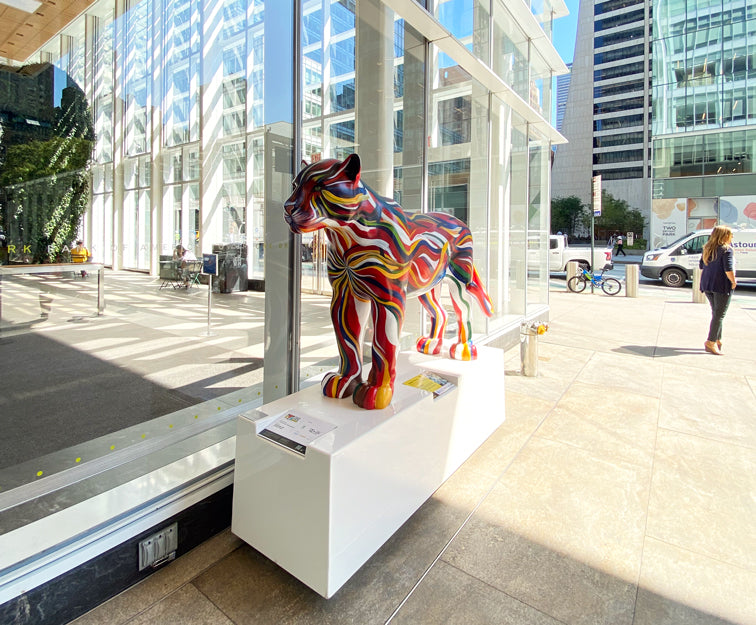The Path of the Jaguar
Wed, Sep 28, 22

The jaguar is the largest cat of the Latin American hemisphere, the place where I was born and raised; and, joining a cause that seeks to protect the species brings me back to childhood memories when my mom, as an environmental lawyer, would fearlessly prosecute people who illegally exploited the Honduran tropical flora and fauna for economic gain.
-
However, the most important takeaway of this project is the everlasting knowledge of the impact jaguars have in the people and communities it touches.
-
It certainly touched my life in a special way.
-
-
How it started
-
Back in September, I was introduced to the organizers of Jaguar Parade, an initiative that started in Brazil with the goal of driving awareness and funds to protect the jaguar. The vision was specific: we wanted to paint a jaguar that would pay homage to the late Dr. Alan Rabinowitz, an American zoologist who dedicated over 30 years of his life to help protect the jaguar through innovation, fearlessness, and persistence. He was the founder and CEO of Panthera, an NGO that spearheaded what has now become the modus operandi for conservation of big cats around the globe.
-
This took me through a journey of discovery - not only of the inspiring story of Dr. Rabinowitz himself, but of the magic behind the jaguars.
-
The inspiration behind "The Path of the Jaguar"
-
The core inspiration behind the piece are characteristics shared by both jaguars and Dr. Rabinowitz: a courageous heart, a fearless vision, and constant movement.
-
The colorful brushstrokes flowing from the heart and the eyes in the 7 sacred colors of the Maya (blue, red, green, white, yellow, black, brown and yellow) pay homage to the ancestral knowledge of pre-Colombian civilizations who revered and respected the jaguar, and the balance the jaguar brings not only to a community, but to the Latin American ecosystem as well.
-
-
Finally, the legacy of Dr. Rabinowitz is primarily reflected in two components: the Panthera logo which is weaved into the sides of the jaguar, and the outline of the Jaguar Corridor on the top side. The latter is a protected stretch of land spanning from the northern part of Mexico to Argentina connecting core jaguar populations across the hemisphere. As mentioned in Pathera's website, the Jaguar Corridor is a collaboration between governments, corporations, and local communities, and the only conservation program that seeks to protect jaguars across the entire range where they currently live.
-
-
The Path of the Jaguar was placed in the Bank of America Tower in Midtown Manhattan and will be on view from September 7th through October 5th. After that, it will go to auction and 100% of the net proceeds will be donated to organizations that are supporting the protection of the jaguar. Auction results will be reported on October 27th.
-
-
The cause and effects of jaguar conservation
-
The main challenges that jaguars face include illegal destruction of their habitat through deforestation, and hunting. Panthera has made impressive progress in protecting the species; however, the strides are still threatened by overpopulation and the economic challenges communities in these underdeveloped countries face.
-
One of the key reasons why it is important to protect the jaguar is because their place at the top of the food chain makes them a necessary species to maintain the ecosystem balanced. In other words, if the jaguar suffers, the effects trickle down to our very own survival as humans. However, the benefits go beyond just that. As Dr. Rabinowitz recounts in his book "An Indomitable Beast, The Remarkable Journey of the Jaguar," after decades of speaking to people throughout the Jaguar Corridor: "the presence of jaguars, whether through economic benefits or spiritual and religious uplift, helped invigorate and strengthen whatever community it was a part of." That is to say, the jaguar's survival benefits us from a scientific, economic and social perspective.
-
A fun fact about jaguars
-
Pre-Columbian civilizations lived with jaguars because they respected and revered the species. However, one of the most important and distinctive characteristics that stand jaguars apart from other large mammals or apex predators is their nonagression. Dr. Rabinowitz reports that "in the wild, there are very few recorded instances of jaguars killing people, and no instances of jaguars becoming a hunter of men, a true man-eater."
-
Resources
-
- More info and location of "The Path of the Jaguar"
- All jaguar sculptures are on view throughout New York city until October 5th. You can see their locations in this map.
- Join online auction of jaguars from October 5th through 27th.
- About Panthera.
- About Dr. Alan Rabinowitz.
- Entrevista en español con WWF acerca del proyecto.


